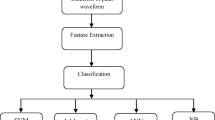Abstract
ECG signal abnormality detection is useful for identifying heart related problems. Two popular abnormality detection techniques are ischaemic beat classification and arrhythmic beat classification. In this work, ECG signal preprocessing and KNN based arrhythmic beat classification are performed to categorize into normal and abnormal subjects. LMS based adaptive filters are used in ECG signal preprocessing, but they consume more time for processing due to long critical path. To overcome this problem, a novel adaptive filter with delayed error normalized LMS algorithm is utilized to attain high speed and low latency design. Low power design is achieved in this design by applying pipelining concept in the error feedback path. R-peak detection is carried out in the preprocessed signal using wavelets for HRV feature extraction. Arrhythmic beat classification is carried out by KNN classifier on HRV feature extracted signal. Classification performance reveals that the proposed DWT with KNN classifier provides the accuracy of 97.5% which is better than other machine leaning techniques.





Similar content being viewed by others
References
Chawla M (2011) PCA and ICA processing methods for removal of artifacts and noise in electrocardiograms: a survey and comparison. Appl Soft Comput 11(2):2216–2226. https://doi.org/10.1016/j.asoc.2010.08.001
Elgendi M, Jonkman M, Boer FD (2009) R wave detection using Coiflets wavelets. 2009 I.E. 35th annual northeast bioengineering conference 1-2. https://doi.org/10.1109/nebc.2009.4967756
Gupta A, Joshi S (2008) Variable step-size LMS algorithm for fractal signals. IEEE Trans Signal Process 56(4):1411–1420. https://doi.org/10.1109/tsp.2007.909374
Jayalalith S, Susan D, Kumari S, Archana B (2014) K-nearest neighbour method of analysing the ECG signal (To Find out the Different Disorders Related to Heart). J Appl Sci 14(14):1628–1632. https://doi.org/10.3923/jas.2014.1628.1632
Jubairahmed L, Satheeskumaran S, Venkatesan C (2017) Contourlet transform based adaptive nonlinear diffusion filtering for speckle noise removal in ultrasound images. Cluster Comput 1–10. https://doi.org/10.1007/s10586-017-1370-x
Kohler B, Hennig C, Orglmeister R (2002) The principles of software QRS detection. IEEE Eng Med Biol Mag 21(1):42–57. https://doi.org/10.1109/51.993193
Kumar M, Weippert M, Vilbrandt R, Kreuzfeld S, Stoll R (2007) Fuzzy evaluation of heart rate signals for mental stress assessment. IEEE Trans Fuzzy Syst 15(5):791–808. https://doi.org/10.1109/tfuzz.2006.889825
Langley P, Bowers E, Wild J, Drinnan M, Allen J, Sims A, Murray A (2003) An algorithm to distinguish ischaemic and non-ischaemic ST changes in the Holter ECG. Comput Cardiol 2003:235–238. https://doi.org/10.1109/cic.2003.1291135
Nouira I, Abdallah A, Kouaja I, Bedoui M (2012) Comparative study of QRS complex detection in ECG. Proc World Acad Sci Eng Technol 71:1447–1451
Osowski S, Hoai L, Markiewicz T (2004) Support vector machine-based expert system for reliable heartbeat recognition. IEEE Trans Biomed Eng 51(4):582–589. https://doi.org/10.1109/tbme.2004.824138
Parhi K, Messerschmitt D (1989) Pipeline interleaving and parallelism in recursive digital filters. I. Pipelining using scattered look-ahead and decomposition. IEEE Trans Acoust Speech Signal Process 37(7):1099–1117. https://doi.org/10.1109/29.32286
Petković D, Ćojbašić Ž, Lukić S (2013) Adaptive neuro fuzzy selection of heart rate variability parameters affected by autonomic nervous system. Expert Syst Appl 40(11):4490–4495. https://doi.org/10.1016/j.eswa.2013.01.055
Rahman MZ, Shaik RA, Reddy DV (2012) Efficient and simplified adaptive noise cancellers for ECG sensor based remote health monitoring. IEEE Sensors J 12(3):566–573. https://doi.org/10.1109/jsen.2011.2111453
Rooijakkers MJ, Rabotti C, Oei SG, Mischi M (2012) Low-complexity R-peak detection for ambulatory fetal monitoring. Physiol Meas 33(7):1135–1150. https://doi.org/10.1088/0967-3334/33/7/1135
Satheeskumaran S, Sabrigiriraj M (2014) A new LMS based noise removal and DWT based R-peak detection in ECG signal for biotelemetry applications. Natl Acad Sci Lett 37(4):341–349
Satheeskumaran S, Sabrigiriraj M (2016) VLSI implementation of a new LMS based algorithm for noise removal in ECG signal. Int J Electron 103:975–984
Stolojescu C, Railean I, Moga S, Isar A (2010) Comparison of wavelet families with application to WiMAX traffic forecasting. 2010 12th international conference on optimization of electrical and electronic equipment 932-937. https://doi.org/10.1109/optim.2010.5510403
Szilagyi S, Szilagyi L (2003) Wavelet transform and neural-network-based adaptive filtering for QRS detection. Proceedings of the 22nd annual international conference of the IEEE engineering in medicine and biology society (Cat. No.00CH37143) 2:1267-1270. https://doi.org/10.1109/iembs.2000.897966
Ting L, Woods R, Cowan C (2005) Virtex FPGA implementation of a pipelined adaptive LMS predictor for electronic support measures receivers. IEEE Trans Very Large Scale Integr (VLSI) Syst 13(1):86–95. https://doi.org/10.1109/tvlsi.2004.840403
Tsipouras M, Fotiadis D, Sideris D (2005) An arrhythmia classification system based on the RR-interval signal. Artif Intell Med 33(3):237–250. https://doi.org/10.1016/j.artmed.2004.03.007
Venkatesan C, Karthigaikumar P, Varatharajan R (2018) FPGA implementation of modified error normalized LMS adaptive filter for ECG noise removal. Cluster Comput 1-9. https://doi.org/10.1007/s10586-017-1602-0
Wiggins M, Saad A, Litt B, Vachtsevanos G (2008) Evolving a Bayesian classifier for ECG-based age classification in medical applications. Appl Soft Comput 8(1):599–608. https://doi.org/10.1016/j.asoc.2007.03.009
Zhai J, Barreto A (2006) Stress detection in computer users based on digital signal processing of noninvasive physiological variables. 2006 international conference of the IEEE engineering in medicine and biology society 1355-1358. https://doi.org/10.1109/iembs.2006.4397662
Zhang J, Zhao H (2010) A novel adaptive bilinear filter based on pipelined architecture. Digit Signal Process 20(1):23–38. https://doi.org/10.1016/j.dsp.2009.06.006
Author information
Authors and Affiliations
Corresponding author
Rights and permissions
About this article
Cite this article
Venkatesan, C., Karthigaikumar, P. & Varatharajan, R. A novel LMS algorithm for ECG signal preprocessing and KNN classifier based abnormality detection. Multimed Tools Appl 77, 10365–10374 (2018). https://doi.org/10.1007/s11042-018-5762-6
Received:
Revised:
Accepted:
Published:
Issue Date:
DOI: https://doi.org/10.1007/s11042-018-5762-6




